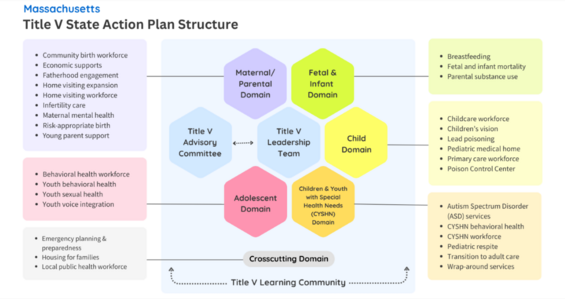Overview
The Maternal and Child Health Block Grant, also known as Title V, is dedicated to improving family health and well-being across generations. Title V enables MA DPH to develop, implement, and evaluate policies and programs for pregnant people, parents, caregivers, infants, children, and youth, including those with special health needs.
Title V State Action Plan 2025-2030
In 2024-2025, Massachusetts conducted a statewide needs assessment to understand strengths and gaps in services, prioritize MCH needs, and develop a five-year state action plan. The needs assessment was an 18-month process engaging a broad array of MCH partners and families to identify the strengths and challenges facing families in Massachusetts. Seven priorities were identified for implementation:
- Maternal/Parental/Reproductive Health: Ensure all Massachusetts residents who are pregnant and give birth and their families live the healthiest life possible, supported by a strong public health infrastructure and healthcare delivery system.
- Perinatal/Infant Health: Ensure all infants are born healthy and thrive in their first year of life, and reduce/eliminate variation in birth outcomes based on community health factors
- Child Health: Optimize the healthy development of all children so they can flourish and reach their full potential through safe, stable, and nurturing relationships and environments
- Adolescent Health: Advance systems that elevate youth voice, strengthen assets, and foster environments where all young people can thrive.
- Children and Youth with Special Health Needs (CYSHN): Strengthen systems of care for Children and Youth with Special Health Needs and their families
- MCH Workforce: Strengthen the MCH workforce to ensure families and communities are supported by high-quality providers that reflect the communities they serve across the maternal and child health ecosystem
- Emergency Preparedness: Strengthen Massachusetts state approach of including MCH needs with emergency preparedness and response efforts and embedding a preparedness lens within MCH programs
The Title V State Action Plan implementation structure and focus areas under each of the seven priorities are shown below:

Performance Measures
The performance measures for the plan are included in this spreadsheet.
-
Open XLSX file, 42.93 KB, Title V performance measures (English, XLSX 42.93 KB)